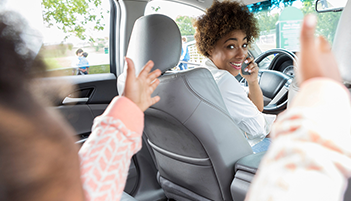HOW CAN WE HELP YOU? Call 1-800-TRY-CHOP
In This Section
What Percentage of Parents Engage in Distracted Driving?

The findings:
About 50 percent of parents reported talking on their cell phones while driving with their young child in the vehicle, while one in three read text messages, and one in seven used social media, according to online surveys of adults across the U.S. The findings, published in a recent study from our Center for Injury Research and Prevention (CIRP) at Children’s Hospital of Philadelphia and the University of Pennsylvania School of Nursing, also reveal that parents who used their cell phones in the car were more likely to engage in other risky driving behaviors, such as not wearing a seat belt when they were a driver and not consistently using their typical child restraint system (CRS) for their child.
Why it matters:
Car crashes remain a leading cause of injury and death in children, topping the list as one of the biggest drivers of childhood mortality in a Health Affairs study earlier this year. Distracted driving — defined as any activity that diverts a driver’s attention away from the roadway — accounts for approximately 25 percent of motor vehicle crashes. With our society’s growing dependence on technology and previous research suggesting that causes of distracted driving by parents include texting, talking, and going online, researchers wanted to identify the specific factors associated with cell phone-related distracted driving in parents of young children.
Who conducted the study:
The team of researchers from CHOP and Penn included Catherine McDonald, PhD, RN, FAAN, senior fellow at CIRP and assistant professor of Nursing at Penn Nursing; Erin Kennedy, an undergraduate nursing student at PENN and part of the 2017 CIRP Research Experience for Undergraduates (REU) program; Linda Fleisher, PhD, MPH, senior scientist at CIRP; and Mark R. Zonfrillo, MD, MSCE, associate fellow at CIRP.
How they did it:
The study team analyzed online surveys of 760 adults across 47 U.S. states. All respondents were at least 18 years old, a parent or caregiver of a child between the ages of 4 and 10, and had driven their oldest child at least six times in the last three months. The surveys covered topics like cell phone use while driving, utilization of child restraint systems (i.e. booster seats, car seats, seat belts), seat belt use while driving, driving under the influence of alcohol, and demographic data.
Quick thoughts:
“When clinicians are discussing child passenger safety with families, they can use the opportunity to ask and educate about parental driving behaviors such as seat belt use and cell phone use while driving,” said Dr. McDonald in a press release. “This type of education is especially pivotal today, as in-vehicle technology is rapidly changing and there is increased — and seemingly constant — reliability on cell phones. However, it is also important to note that even parents who did not engage in other risky driving behaviors, such as not wearing a seat belt as a driver or driving under the influence of alcohol, still used their cell phones while driving.”
What's next:
In the study, the researchers note that the findings lay the foundation for future studies on child passenger safety and parental driving behavior. In time, these studies may drive the development and implementation of multilevel initiatives to decrease childhood deaths caused by distracted driving, such as interventions that address CRS use and/or distracted driving, engineering modifications, and legislation directed toward various risky driving behaviors. Meanwhile, the authors also suggest that one potential way to safeguard future adolescent drivers is by studying whether a child’s observation of their parent’s risky driving behaviors — such as seat belt or cell phone use — might impact that child’s later behavior as a young driver.
Where the study was published:
Where to learn more:
Read the CHOP press release. Local and national media outlets also featured the new findings, including Newsweek, Philly.com, and 6ABC.


